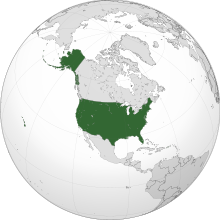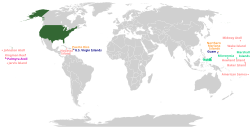
Back Еиду Америкатәи Аштатқәа AB Amirika Syarikat ACE Америкэ Штат Зэхэтхэр ADY Verenigde State van Amerika AF USA ALS የተባበሩት ግዛቶች AM Amilika AMI Estaus Unius AN Geanedan Ricu America ANG अमेरिका ANP
United States of America | |
|---|---|
| Motto: "In God We Trust"[1] Other traditional mottos:[2]
| |
| Anthem: "The Star-Spangled Banner"[3] | |
| Capital | Washington, D.C. 38°53′N 77°1′W / 38.883°N 77.017°W |
| Largest city | New York City 40°43′N 74°0′W / 40.717°N 74.000°W |
| Official languages | None at the federal level[a] |
| National language | English[b] |
| Ethnic groups | By race:
By origin:
|
| Religion (2022)[7] |
|
| Demonym(s) | American[c][8] |
| Government | Federal presidential republic |
| Joe Biden | |
| Kamala Harris | |
| Mike Johnson | |
| John Roberts | |
| Legislature | Congress |
| Senate | |
| House of Representatives | |
| Independence from Great Britain | |
| July 4, 1776 | |
| March 1, 1781 | |
| September 3, 1783 | |
| June 21, 1788 | |
| May 5, 1992 | |
| Area | |
• Total area | 3,796,742 sq mi (9,833,520 km2)[9] (3rd[d]) |
• Water (%) | 7.0[10] (2010) |
• Land area | 3,531,905 sq mi (9,147,590 km2) (3rd) |
| Population | |
• 2023 estimate | |
• 2020 census | |
• Density | 87/sq mi (33.6/km2) (185th) |
| GDP (PPP) | 2024 estimate |
• Total | |
• Per capita | |
| GDP (nominal) | 2024 estimate |
• Total | |
• Per capita | |
| Gini (2020) | medium |
| HDI (2022) | very high (20th) |
| Currency | U.S. dollar ($) (USD) |
| Time zone | UTC−4 to −12, +10, +11 |
• Summer (DST) | UTC−4 to −10[g] |
| Date format | mm/dd/yyyy[h] |
| Driving side | right[i] |
| Calling code | +1 |
| ISO 3166 code | US |
| Internet TLD | .us[16] |
The United States of America (USA or U.S.A.), commonly known as the United States (US or U.S.) or America, is a country primarily located in North America. It is a federation of 50 states, a federal capital district (Washington, D.C.), and 326 Indian reservations. Outside the union of states, it asserts sovereignty over five major unincorporated island territories and various uninhabited islands.[j] The country has the world's third-largest land area,[d] second-largest exclusive economic zone, and third-largest population, exceeding 334 million.[k]
Paleo-Indians migrated across the Bering land bridge more than 12,000 years ago. British colonization led to the first settlement of the Thirteen Colonies in Virginia in 1607. Clashes with the British Crown over taxation and political representation sparked the American Revolution, with the Second Continental Congress formally declaring independence on July 4, 1776. Following its victory in the Revolutionary War (1775–1783), the country continued to expand across North America. As more states were admitted, sectional division over slavery led to the secession of the Confederate States of America, which fought the remaining states of the Union during the 1861–1865 American Civil War. With the Union's victory and preservation, slavery was abolished nationally. By 1890, the United States had established itself as a great power. After Japan's attack on Pearl Harbor in December 1941, the U.S. entered World War II. The aftermath of the war left the U.S. and the Soviet Union as the world's two superpowers and led to the Cold War, during which both countries engaged in a struggle for ideological dominance and international influence. Following the Soviet Union's collapse and the end of the Cold War in 1991, the U.S. emerged as the world's sole superpower.
The U.S. national government is a presidential constitutional republic and liberal democracy with three separate branches: legislative, executive, and judicial. It has a bicameral national legislature composed of the House of Representatives, a lower house based on population; and the Senate, an upper house based on equal representation for each state. Substantial autonomy is given to states and several territories, with a political culture that emphasizes liberty, equality under the law, individualism, and limited government.
One of the world's most developed countries, the United States has had the largest nominal GDP since 1890 and accounted for 15% of the global economy in 2023.[l] It possesses by far the largest amount of wealth of any country and the highest median income per capita of any non-microstate. The U.S. ranks among the world's highest in economic competitiveness, productivity, innovation, human rights, and higher education. Its hard power and cultural influence have a global reach. The U.S. is a founding member of the World Bank, IMF, Organization of American States, NATO, World Health Organization, and a permanent member of the UN Security Council.
- ^ 36 U.S.C. § 302
- ^ "The Great Seal of the United States" (PDF). U.S. Department of State, Bureau of Public Affairs. 2003. Retrieved February 12, 2020.
- ^ "An Act To make The Star-Spangled Banner the national anthem of the United States of America". H.R. 14, Act of March 3, 1931. 71st United States Congress.
- ^ "2020 Census Illuminates Racial and Ethnic Composition of the Country". United States Census. Retrieved August 13, 2021.
- ^ "Race and Ethnicity in the United States: 2010 Census and 2020 Census". United States Census. Retrieved August 13, 2021.
- ^ "A Breakdown of 2020 Census Demographic Data". NPR. August 13, 2021.
- ^ Staff (June 8, 2007). "In Depth: Topics A to Z (Religion)". Gallup, Inc. Retrieved November 1, 2023.
- ^ Compton's Pictured Encyclopedia and Fact-index: Ohio. 1963. p. 336.
- ^ Areas of the 50 states and the District of Columbia but not Puerto Rico nor other island territories per "State Area Measurements and Internal Point Coordinates". Census.gov. August 2010. Retrieved March 31, 2020.
reflect base feature updates made in the MAF/TIGER database through August, 2010.
- ^ "The Water Area of Each State". United States Geological Survey. 2018. Retrieved January 29, 2024.
- ^ Bureau, US Census. "U.S. Population Trends Return to Pre-Pandemic Norms as More States Gain Population". Census.gov. Retrieved December 23, 2023.
- ^ "U.S. Census Bureau Today Delivers State Population Totals for Congressional Apportionment". United States Census. Retrieved April 26, 2021. The 2020 census is as of April 1, 2020.
- ^ a b c d "World Economic Outlook Database, April 2024 Edition. (United States)". www.imf.org. International Monetary Fund. April 16, 2024. Retrieved April 16, 2024.
- ^ Bureau, US Census. "Income and Poverty in the United States: 2020". Census.gov. p. 48. Retrieved July 26, 2022.
- ^ "Human Development Report 2023/24" (PDF). United Nations Development Programme. March 13, 2024. Retrieved March 13, 2024.
- ^ "The Difference Between .us vs .com". Cozab. January 3, 2022. Archived from the original on April 16, 2023. Retrieved August 11, 2023.
- ^ U.S. State Department, Common Core Document to U.N. Committee on Human Rights, December 30, 2011, Item 22, 27, 80. And U.S. General Accounting Office Report, U.S. Insular Areas: application of the U.S. Constitution Archived November 3, 2013, at the Wayback Machine, November 1997, pp. 1, 6, 39n. Both viewed April 6, 2016.
- ^ "China". The World Factbook. Retrieved June 10, 2016.
- ^ "United States". Encyclopædia Britannica. Archived from the original on December 19, 2013. Retrieved January 31, 2010.
Cite error: There are <ref group=lower-alpha> tags or {{efn}} templates on this page, but the references will not show without a {{reflist|group=lower-alpha}} template or {{notelist}} template (see the help page).




